13.4: Howard Shore's Score to Lord of the Rings
- Page ID
- 171326
Howard Shore's Leitmotifs in Lord of the Rings.
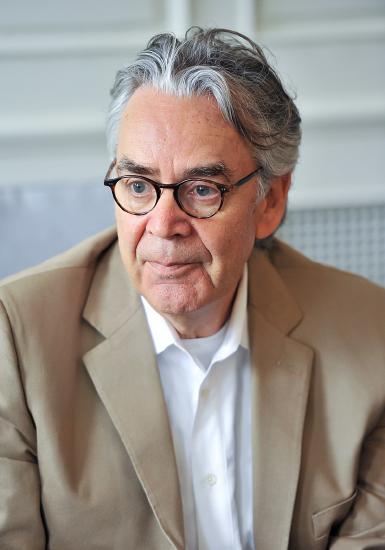 Howard Shore (b. 1946) is a Canadian-born composer who has scored more than 80 films. He most-known for his scores to the Lord of the Rings trilogy as well as the Hobbit trilogy, the former for which he received 3 Academy Awards. Shore's approach to leitmotivic scoring in the Lord of th Rings is truly a work of meticulous planning, creating a large network of different themes for characters and places, all connected musically at the smallest level. By connecting these different themes together, Shore creates a thematic network of interrelated themes, that all still retain their own unique identity. Though these techniques are present in some of John Williams' works, Shores' music is of special interest, because every single important musical theme may be traced back to the main theme! In this way, Shore is able to tell the entire story of the protagonists's fellowship through his compositional techniques!
Howard Shore (b. 1946) is a Canadian-born composer who has scored more than 80 films. He most-known for his scores to the Lord of the Rings trilogy as well as the Hobbit trilogy, the former for which he received 3 Academy Awards. Shore's approach to leitmotivic scoring in the Lord of th Rings is truly a work of meticulous planning, creating a large network of different themes for characters and places, all connected musically at the smallest level. By connecting these different themes together, Shore creates a thematic network of interrelated themes, that all still retain their own unique identity. Though these techniques are present in some of John Williams' works, Shores' music is of special interest, because every single important musical theme may be traced back to the main theme! In this way, Shore is able to tell the entire story of the protagonists's fellowship through his compositional techniques!
The Lord of the Rings, as written by J.R.R. Tolkien in 1954-55, takes place in a high-fantasy setting. In its fictional history, we learn that eons ago, a dark sorcerer named Sauron along with some Elves had forged 19 "rings of power" to be dispersed among the different races of Middle Earth: 3 were given to Elves, 7 were given to Dwarves, and 9 were given to Humans. Sauron then created his own "One Ring" in the fires of Mount Doom to control all of the others, and those who wore them. The Lord of the Rings tells the story of Elves, Dwarves, Humans, and Hobbits forming a Fellowship to destroy the One Ring. Shore's music not only enhances the unfolding drama, but also foreshadows dramatic events through his network of related musical themes!
(above): picture of Howard Shore by Sam Santos. CC BY 2.0.
Connecting Different Themes through Small Gestures.
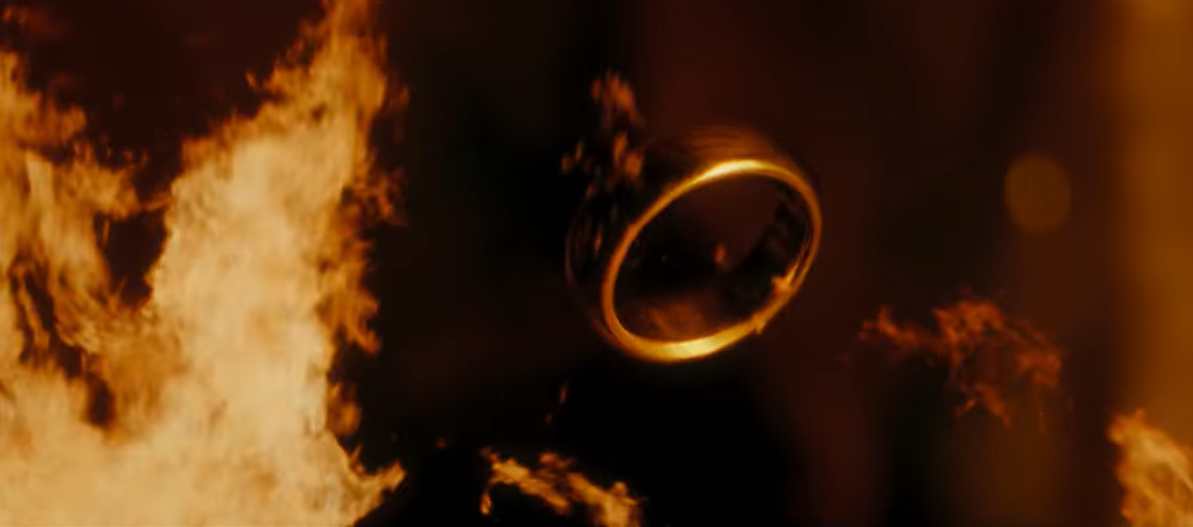
Picture of the One Ring forged by Sauron in the Fires of Mount Doom (screenshot taken from YouTube).
As one would expect, Howard Shore provides the main characters their own musical themes, and provides two recurring main themes. The first main theme accompanies the opening title of the first movie Fellowship of the Ring with a theme called "The One Ring." Watch the opening cinematic from the first film The Fellowship of the Rings, which describes the story's fictional history. The ominous music you hear in the background at the beginning is a variant of the movie's first main theme, which musicologist Doug Adams refers to the opening statement as "One Ring to the Rule them All" (see below).
After watching the opening cinematic, listen to the opening few seconds of the theme without any narration. This ominous melody ("One Ring to the Rule them All") involves a very short two-measure melody that consists of a falling and ascending melodic gesture, both labeled x and y (see the example below). Later in the film, we hear another ominous piece of music called "Seduction of the Ring," which sounds when protagonists hold the Ring of Power, which slowly corrupts even the most well-intentioned being. This theme (seen below) consists of a rising and falling gesture labeled y: this gesture grows out of the same gesture that was heard in the opening title track "One Ring to Rule Them All."

Opening phrases of various themes in Howard Shores' Lord of the Rings score. (FOTR: Fellowship of the Rings; TTT: The Two Towers).
This same y gesture begins the Hobbits theme called "The Shire" (seen above). The ominous nature of the Ring themes is gone, and we hear a peaceful almost quasi-folk style to this beautiful melody to depict the simple-natured Hobbits. Listen to this beautiful "Hobbit" theme, paying attention to the first few notes, then watch this scene where Gandalf visits the Hobbits in the shire. At 4:28, you'll hear a recorder playing this peaceful melody as Gandalf rides into town. By beginning the Hobbits' theme with the same musical gesture as the "One Ring" and the "Seduction of the Ring," Shore musically depicting the Hobbits' corruption when they get a hold of the ring!
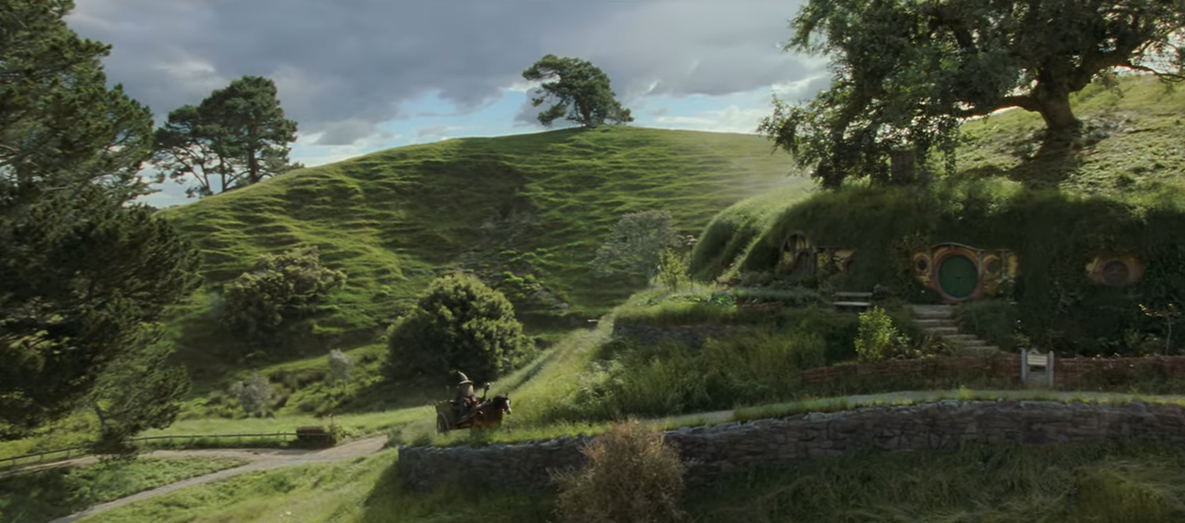
The Fellowship of the Rings, the Shire (where the Hobbits live). The "Shire" theme plays here at 4:28 (screenshot taken from YouTube).
The diagram above displays 3 rows: the top row shows the three aforementioned musical themes, all using the same y gesture, depicting the Hobbits and the Rings' themes. However, the story is more than just the Hobbits: the story focuses on a Fellowship—a pact among different races—to come together and destroy evil! This Fellowship is musically represented by the "Fellowship Theme," shown in the middle row of the diagram above. The "Fellowship Theme" acts as the movie's second main theme. As you can see, this theme begins with the same x gesture from "One Ring to Rule Them All," and moves directly into the y gesture from the Ring and Hobbit themes! Listen to this very brief statement of the "Fellowship Theme," paying close attention to how these two different x and y gestures join together to create a unified heroic melody.
Shore brilliantly ties the "Shire" theme to the "Fellowship" theme in the beginning of the first film. Here, the two Hobbits Frodo and Sam leave the Shire for the first time in their lives, on a quest to destroy the One Ring. The Fellowship has not yet been fully created, but with these two Hobbits, its beginnings have been formed. Watch this scene where Gandolf send the Hobbits on their way: at 1:26, you'll hear the "Shire Theme" as Sam explains that he's never left the Shire before. Then, at 1:40, the music bleeds into the "Fellowship Theme" very subtly as Frodo says, "Remember what Bilbo used to say." This subtle statement only suggests the formation of the Fellowship, but we don't yet hear it in all of its glory.
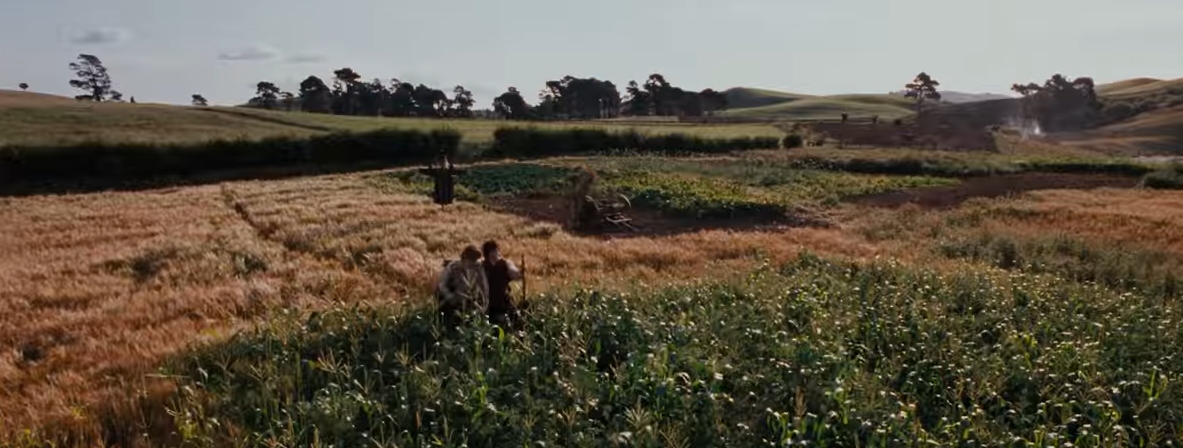
The Fellowship of the Rings: Frodo and Sam leave the Shire. Here, we hear the "Shire/Hobbit" theme immediately followed by a subtle statement of the "Fellowship" theme at 1:26. This musically foreshadows the scene at the Council of Elrond where the entire Fellowship is created. (Screenshot from YouTube).
Later in the film, representatives from all of the races have a meeting at the "Council of Elrond" to discuss how best to destroy the Ring of Power. Here, Bilbo volunteers to destroy the Ring, confessing that he doesn't know the way. In response, 8 others volunteer to accompany him including 3 other Hobbits (Sam, Merry, and Pippin), Gandolf the Wizard, Gimli the Dwarf, Legolas the Elf, and the Humans Aragorn and Boromir. At this point in the film, we finally hear the entire "Fellowship" theme in all of its glory. Watch this scene of the Council of Elrond, paying attention to timestamp 2:56, where you'll hear this iconic "Fellowship" theme theme. Shore's foreshadowing techniques connect not only the Ring and the Hobbits, but out of these themes, he creates a unique theme that represents the entire cast of protagonists, unified in defeating Sauron's nefarious deeds!
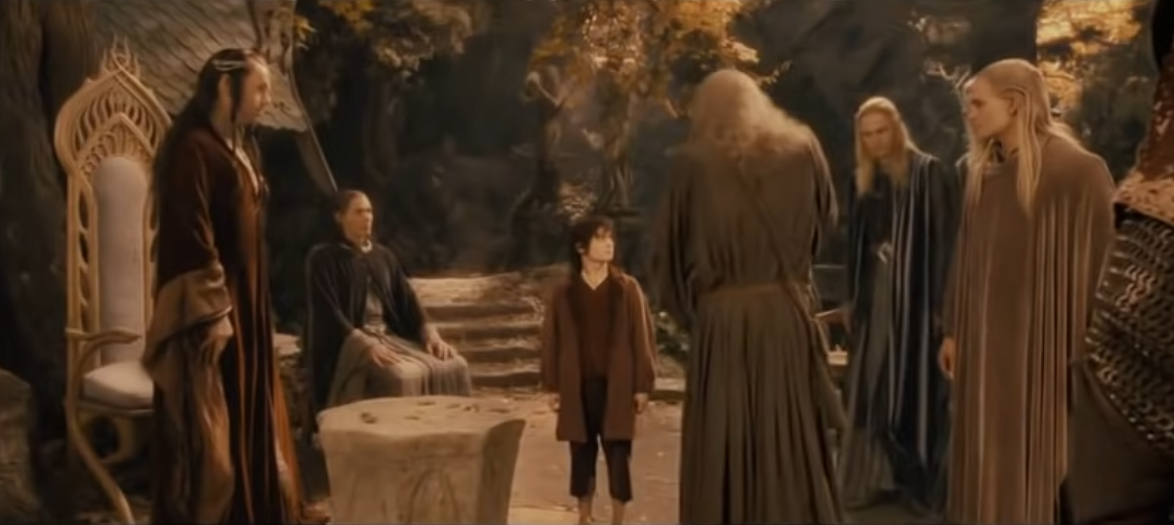
The Fellowship of the Rings, Council of Elrond scene (screenshot from YouTube). Here, we hear the "Fellowship" theme stated in full for the first time at 2:56.
As if this wasn't enough, Shore continues to connect the "Fellowship" theme (which itself is derived from the "One Ring to Rule them All" theme) to other characters with their own character themes! For instance, the Human Aragorn is musically depicted with his own self-named theme (seen above). This theme is mostly comprised of 2-note rising gestures (inversions of the descending gesture of the "One Ring to Rule them All" theme), and a rising 3-note gesture heard in all of the "Ring" and "Hobbit" themes. Moreover, because these themes are all connected through these gestures, we can see and hear a connection between Aragorn's theme and the Fellowship theme itself! Watch this scene from Fellowship of the Rings where Aragorn heroically staves off the enemies while Frodo runs to safety. At 1:43, you'll hear "Aragorn's Theme" as he fends off the enemies. Gandalf the Wizard's theme is also connected to these themes: in the second film The Two Towers, Gandolf (now a White Wizard) calls his horse Shadowfax to his aid. As he rides his faithful steed into the distance, we hear "The White Rider," (seen above), which is comprised almost solely of the descending x gesture from the "Fellowship" theme. Watch this scene from The Two Towers, paying special attention to 0:58. At this moment, you'll hear a triumphant statement of the "White Rider," representing the White Wizard and his horse.
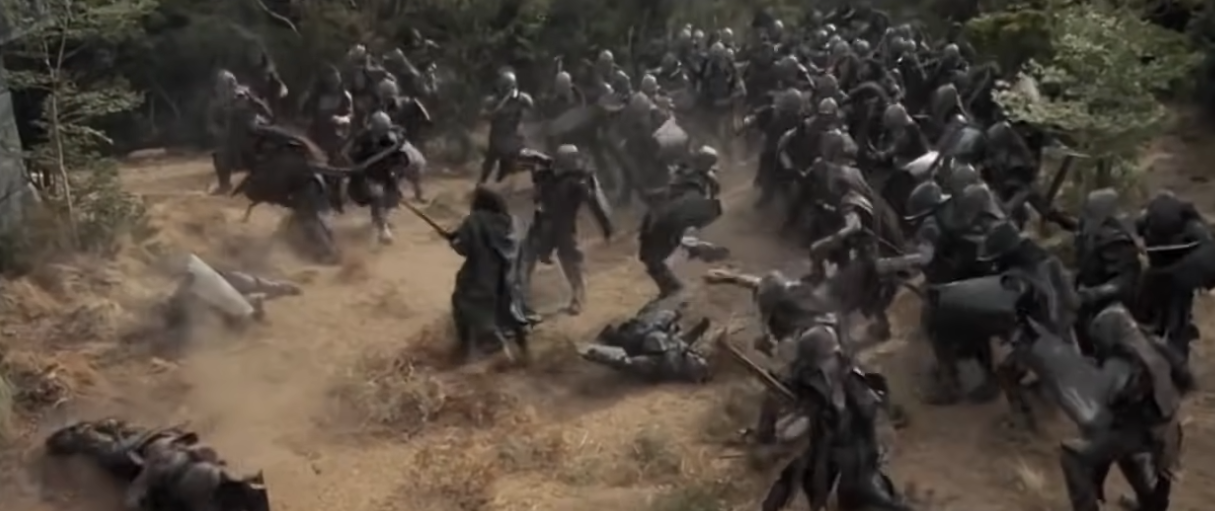
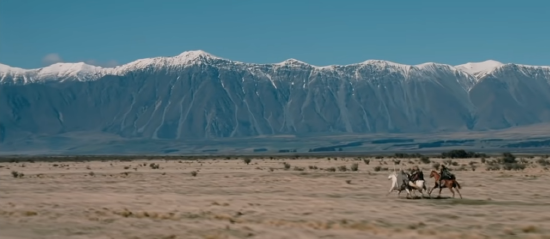
(left): Fellowship of the Rings, Aragon defends Frodo (screenshot from YouTube). During this scene, we hear "Aragorn's Theme" at 1:43.
(right): Gandalf rides his horse into the distance (screenshot from YouTube). During this scene, we hear "The White Rider" at 0:58.
These are just a few of the leitmotivic connections between all of the themes in Howard Shore's scoring to the Lord of the Rings trilogy. As you can see, there are many subtle connections that connect various themes together---and we haven't even discussed singular transformational techniques! These types of techniques are found in many epic franchises, but are also found in some movies that you might never expect. Movies like Titanic and Groundhog Day and even How to Train Your Dragon also use leitmotivic techniques in their soundtracks in ways to enhance the dramatic and emotional connection between the film and its audience (though perhaps not as sophisticated as found here!)

